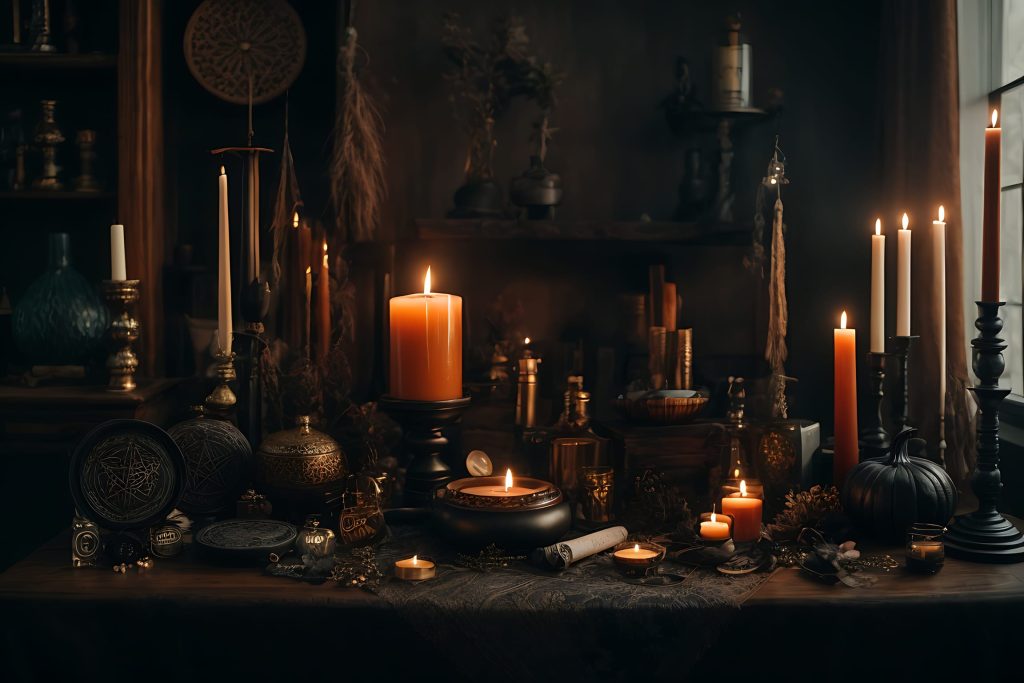In the labyrinthine corridors of the 21st century, where the digital and the mystical entwine, an ancient practice is being reborn. Witchcraft, once relegated to the hushed tones of cautionary tales and the sensationalism of historical witch trials, is now resurfacing as a beacon of empowerment and spiritual awakening. This contemporary reimagining of the craft is a silent revolution, a resurgence that defies the clichéd caricatures and seeks to redefine witchcraft’s place in modern culture.
Gone are the days when witches were synonymous with malevolent forces and dark arts. Today, modern witchcraft is celebrated as an emblem of feminist strength, a conduit for social change, and a pathway to personal growth. The craft has cast off the chains of its misunderstood past, revealing itself as a harmonious blend of tradition and innovation, where ancient rituals meet the conveniences of modern technology.

As we peel back the veil on this cultural phenomenon, we will explore the intricate spell it has woven on those who walk the path of the witch in today’s world. From popular culture’s infatuation with sorcery and enchantment to the tangible practices of solitary practitioners and covens alike, witchcraft has enchanted a new audience, hungry for connection and meaning in an often-disenchanted world.
Join me, as we embark on a journey to understand the magnetic pull of modern witchcraft and its rising influence on society. We will illuminate the corners of this mystical realm, offering insights for both the curious and the devout. Through this exploration, we will uncover the truth behind the craft’s resurgence and the reasons it continues to captivate and thrive within the cultural pulse of our times.
The Rebirth of Witchcraft in the Modern Era
The annals of history are steeped in the arcane lore of witchcraft, a practice as old as humankind itself. In ancient times, the witch was often seen as a revered healer, a wise woman, or a sage who served as a bridge between the earthly and the ethereal. As the centuries turned, the perception of witchcraft morphed under the weight of religious and cultural shifts, leading to a period where fear and misunderstanding cast a shadow over the craft, culminating in the harrowing witch trials that swept across Europe and the New World.
Yet, from the ashes of the old, witchcraft has experienced a renaissance, a rebirth that transcends the fear-inducing stereotypes of yesteryear. In the modern era, witches are reclaiming the narrative, stepping into the light with a practice that honors the heritage while embracing the nuances of contemporary life. The modern witch can be anyone, from every walk of life, finding solace and power in the rituals and beliefs that define the craft.
Today’s witchcraft is characterized by its inclusivity and diversity. It is no longer tethered to a singular image or dogma but is instead a kaleidoscope of traditions and paths. Practitioners draw from Wicca, Paganism, and a multitude of other folk practices, creating a rich tapestry of spirituality that reflects the pluralism of the modern age.

The craft now embraces individuals from all genders, sexual orientations, and ethnic backgrounds, recognizing the unique energies and perspectives each person brings to the altar. This shift from the traditional, often exclusive, views of witchcraft has fostered a community that is as varied as it is vibrant.
As we delve deeper into the rebirth of witchcraft in the modern era, we witness a cultural phenomenon that intertwines the threads of ancient mysticism with the fabric of modern identity. It is a reawakening that speaks to the human desire for connection with the natural world, the unseen forces, and, most profoundly, with one another. Through this lens, the modern witch finds empowerment in self-expression and the freedom to craft a spiritual path that is authentically their own.
In the following sections, we will continue to explore the facets of this rebirth, illuminating the path of the modern witch and the craft that has captivated the hearts of so many in this, our modern era.
Why Witchcraft Appeals to the Contemporary Soul
In today’s fast-paced, technology-driven world, where existential questions often go unanswered, many are turning to the ancient practice of witchcraft to fill a spiritual void. The craft’s growing appeal can be attributed to several core desires that resonate deeply with the contemporary soul.
Personal Empowerment:
One of the most powerful draws of modern witchcraft is the sense of personal empowerment it provides. In a society that often promotes conformity, witchcraft encourages individuality, self-discovery, and the harnessing of one’s inner power. “Witchcraft has given me a sense of control over my destiny,” shares Luna, a practitioner I spoke with. “In my spells and rituals, I find strength and the ability to influence my world in a positive way.”
Connection with Nature:
Another facet of witchcraft’s allure is its intrinsic connection to the natural world. The craft encourages a harmonious relationship with the Earth and its cycles, which can be profoundly grounding and healing. “There’s something incredibly therapeutic about aligning your life with the phases of the moon or the changing seasons,” explains Rowan, a green witch dedicated to plant-based magic.
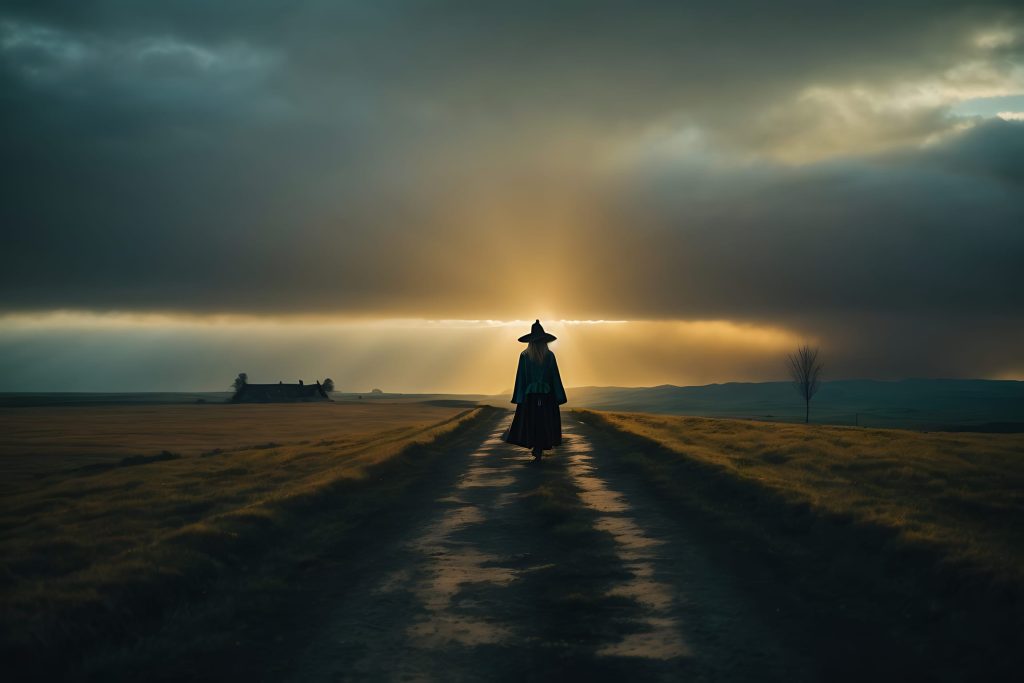
Community and Belonging:
The modern witchcraft movement fosters a sense of community and belonging. For many, it offers a sanctuary where like-minded individuals can come together to share knowledge, experiences, and support. “I’ve found my tribe within the witchcraft community,” says Ash, a member of a local coven. “It’s a space where I’m understood and can freely express my spirituality.”
Spiritual Flexibility:
In contrast to more dogmatic religious structures, witchcraft is often lauded for its spiritual flexibility. Practitioners can tailor their path to fit their personal beliefs and lifestyle. “Witchcraft isn’t one-size-fits-all. I can weave my own beliefs into my practice and make it uniquely mine,” states Jade, who combines elements of her ancestral heritage with her craft.
Coping and Healing:
For many, witchcraft serves as a tool for coping with the stresses of modern life and for healing emotional and psychological wounds. Rituals and spells can act as therapeutic exercises, providing solace and a means to process and release negative energy. “Casting a circle is my way of creating a safe space to heal and reflect,” shares Orion, who uses the craft as a form of self-care.
The reasons for witchcraft’s appeal in the contemporary era are as varied as the practitioners themselves. Witchcraft offers a refuge from the chaos of the modern world, a place where one’s inner voice can be heard and revered.
Search for Meaning:
In an age where traditional religions may not resonate with everyone, witchcraft offers an alternative spiritual path that is rich with symbolism and meaning. “Witchcraft helps me to weave my own narrative of the universe and my place within it,” says Sage, a solitary practitioner who incorporates astrological elements into her rituals.
Empowerment through Knowledge:
Witchcraft also places a high value on knowledge and learning, drawing those who are eager to explore the hidden workings of the world. “There’s a profound sense of empowerment that comes from learning about herbs, crystals, and the energies they carry,” explains Thorn, an eclectic witch with a vast library of grimoires and herbal compendiums.
Reclaiming Heritage:
For some, modern witchcraft is a way to reconnect with ancestral roots and reclaim a heritage that may have been suppressed or lost over time. “Through the craft, I honor my ancestors and the wisdom they passed down,” says Willow, who practices traditional folk magic inspired by her cultural background.
Inclusivity and Acceptance:
Witchcraft’s inclusive nature makes it accessible to those who may feel marginalized or excluded from other spiritual communities. Its celebration of diversity allows individuals from all walks of life to find their place within the craft. “As a queer person, I’ve found acceptance and understanding within witchcraft that I haven’t always experienced elsewhere,” shares Phoenix, who identifies as a genderfluid witch.
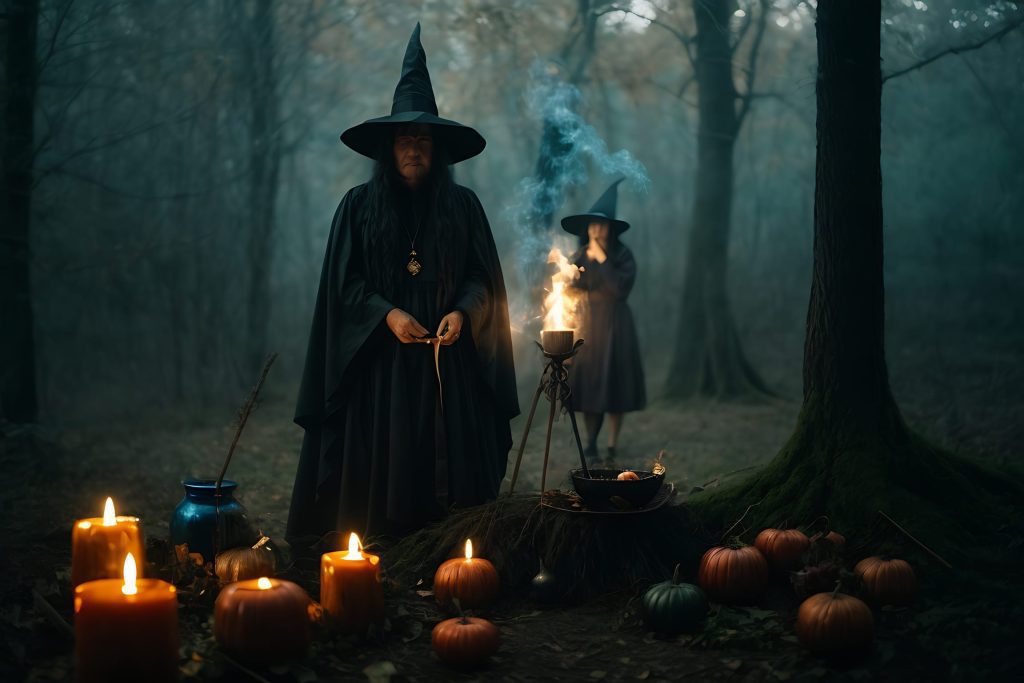
These voices from the witchcraft community highlight the multifaceted appeal of the craft. It is a spiritual practice that honors the past, enriches the present, and embraces the future. As we continue to explore the resurgence of witchcraft, it becomes clear that its relevance today lies in its ability to adapt to the evolving human experience, offering a deeply personal and transformative path for those who choose to walk it.
In the next section, we’ll delve into the representations of witchcraft in popular culture and how these depictions have influenced public perceptions and contributed to the craft’s growing popularity.
Modern Witchcraft and its Role in the Wellness Movement
The tendrils of witchcraft have entwined with the burgeoning wellness movement, a testament to the craft’s versatile nature and its alignment with holistic health. In a world where the lines between the physical, mental, and spiritual realms are increasingly blurred, witchcraft offers tools and philosophies that harmonize with contemporary wellness practices, providing a more integrative approach to well-being.
Witchcraft and Self-Care:
Self-care has become a significant aspect of modern wellness, and witchcraft contributes to this narrative by offering rituals and practices that promote self-nurturing. Activities like meditative spellwork, crafting herbal remedies, and energy cleansing are not only seen as magical practices but also as therapeutic exercises that support individual self-care routines.
Crystal Healing and Aromatherapy:
Crystal healing and aromatherapy, once considered niche or alternative, have gained mainstream acceptance as methods for promoting emotional and spiritual health. Witchcraft, with its long-standing use of crystals and herbs for metaphysical purposes, dovetails with these practices. Amethyst for tranquility, rose quartz for love, and sage for purification are now commonplace in wellness centers and yoga studios.
The Commercialization of Witchcraft:
As with many cultural phenomena, the popularity of witchcraft has led to its commercialization. The marketplace burgeons with witchcraft-related products: from tarot decks and ritual kits to subscription boxes filled with magical supplies. While these products make the craft more accessible, they also raise questions about the commodification of spiritual practices and the potential dilution of their significance.
Ethical Considerations and Authenticity:
With the commercialization of witchcraft comes the responsibility to engage with the craft ethically. Consumers and practitioners alike are encouraged to consider the sources of their tools and the authenticity of the products they use. “It’s important to honor the roots of these practices and support ethical providers,” cautions Rowan, an herbalist and witch who emphasizes the importance of sustainable sourcing.
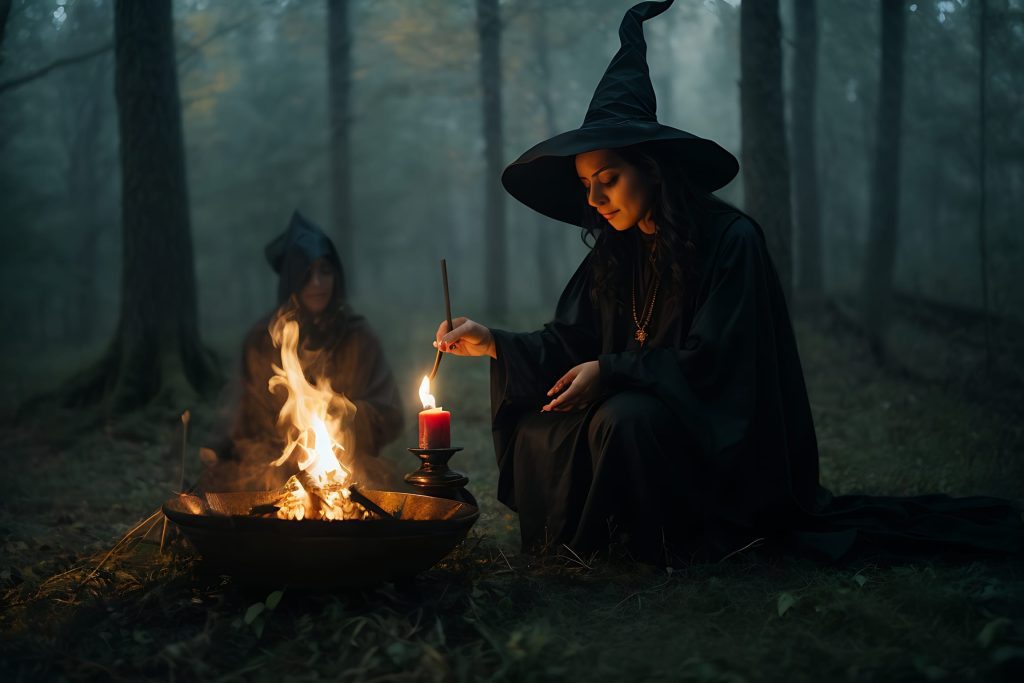
Integration with Holistic Therapies:
Witchcraft’s role in wellness extends to its integration with holistic therapies such as reiki, acupuncture, and yoga. These modalities, rooted in the balance of energy within the body, complement the energetic work found in witchcraft. The incorporation of intention-setting and mindfulness practices within these therapies further illustrates the synergy between witchcraft and wellness.
Mindfulness and Meditation:
Mindfulness and meditation are cornerstones of both the wellness movement and modern witchcraft. The art of grounding oneself through meditation is a shared practice that enhances awareness and connection to the present moment. For the modern witch, this act of mindfulness is often imbued with intention – transforming it into a magical act that can clear the mind, focus the will, and consecrate space for sacred work.
Rituals for Wellness:
The structured nature of ritual in witchcraft offers a framework for those seeking respite from the chaos of daily life. Ritual baths, moon ceremonies, and the crafting of protective amulets serve as therapeutic anchors that many find lacking in conventional wellness paradigms. “Performing a ritual is my way of setting aside time for myself, to heal and to reflect,” shares Sage, who incorporates lunar cycles into her personal wellness rituals.
Educational Resources and Workshops:
To meet the growing demand for knowledge on how to integrate witchcraft with wellness, a proliferation of workshops, online courses, and books has emerged. These resources educate individuals on how to responsibly and effectively use magical practices to enhance well-being. “Proper education ensures that the practices are respected and that their benefits are maximized,” notes Thorne, an educator in the fields of both wellness and witchcraft.
Consumer Awareness and Discernment:
As witchcraft continues to weave its way into the wellness industry, consumers are becoming more discerning about the authenticity and origins of the products and practices they adopt. There is a growing movement within the community to return to the roots of the craft, focusing on personal empowerment and the ethical use of natural resources.
Balancing Tradition with Innovation:
The challenge and opportunity for modern witchcraft within the wellness movement lie in balancing tradition with innovation. While it is essential to honor the historical and cultural origins of the craft, there is also room for adaptation and growth to meet the evolving needs of practitioners seeking solace and strength in an ever-changing world.
The intersection of witchcraft and wellness is a reflection of a collective desire for deeper spiritual engagement and a more holistic approach to health. As modern witchcraft continues to influence wellness practices, it encourages a balanced dialogue between ancient wisdom and modern living, inviting practitioners to cultivate a harmonious and empowered path to well-being.
Witchcraft as a Form of Rebellion and Empowerment
The resurgence of witchcraft in the modern world is not merely a trend; it is a powerful statement of defiance against the normative structures of society. In the act of reclaiming the term “witch,” individuals find not only a path to personal liberation but also a potent symbol of resistance and feminist empowerment. The craft has become a sanctuary for those who resist the status quo, offering a voice to the marginalized and a community to those who have long been silenced.
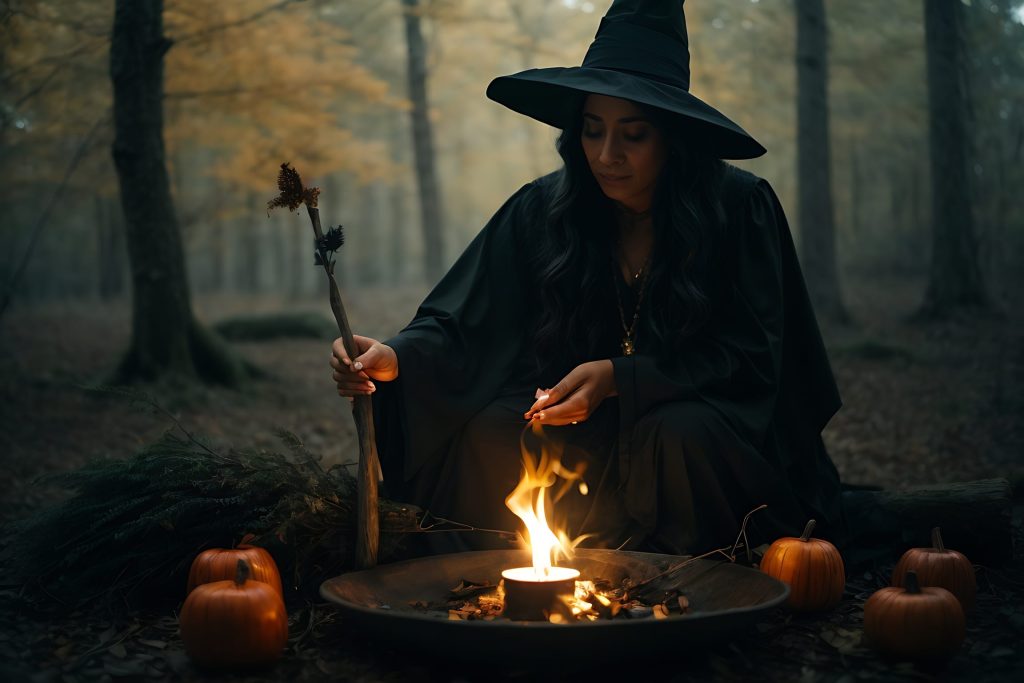
Witchcraft and Feminist Empowerment:
The historical persecution of witches is often interpreted as an assault on women’s autonomy and knowledge. Today, modern witchcraft turns this narrative on its head, celebrating the witch as an archetype of female strength and sovereignty. “Embracing witchcraft was my way of embracing my power as a woman,” declares Morgan, a practitioner who integrates feminist theory into her craft. By tapping into the feminist undercurrents of witchcraft, practitioners engage in a form of spiritual activism that honors the legacy of their foremothers while forging new paths of empowerment.
The Craft as Resistance:
Witchcraft’s emphasis on personal agency and the subversion of traditional power dynamics makes it a natural ally for those engaged in social and political resistance. The craft provides a framework for individuals to manifest their intentions for change, whether through spellwork aimed at justice or rituals that heal the wounds of societal discord. “Witchcraft is my form of protest,” shares Raven, a witch actively involved in community advocacy. “It allows me to channel my energies towards the change I want to see in the world.”
Marginalized Groups and Witchcraft:
The inclusivity of witchcraft has made it particularly appealing to marginalized groups. For people of color, the LGBTQ+ community, and other disenfranchised individuals, the craft offers a space where their identities and experiences are validated and celebrated. “Finding witchcraft was like finding a home where all of me was welcome,” says Phoenix, whose practice is deeply intertwined with their LGBTQ+ identity. The rise of witchcraft among these groups is not only a search for spiritual connection but also a reclaiming of space in a world that often overlooks them.
Community and Solidarity:
Witchcraft fosters a sense of solidarity among its practitioners. Covens and witchcraft collectives provide a supportive environment where individuals can share knowledge, offer mutual aid, and strengthen community ties. “My coven isn’t just a group of witches; it’s a family of like-minded souls who uplift each other,” explains Willow, a coven leader who emphasizes the importance of communal empowerment. This solidarity extends beyond ritual circles to online forums, social media groups, and public gatherings, knitting together a global community of witches who advocate for each other and for broader social causes.
Reclaiming Identity and Heritage:
Witchcraft also serves as a conduit for individuals to explore and reclaim ancestral practices and cultural identities that have been suppressed by colonialism and mainstream religious movements. “In practicing the craft, I’m reconnecting with the spiritual traditions of my ancestors that were lost to time and oppression,” says Asha, who incorporates elements of her indigenous heritage into her rituals. This aspect of witchcraft empowers practitioners to reconstruct and honor their personal and collective histories.
The Witch as an Icon of Nonconformity:
In the figure of the witch, many find an icon of nonconformity and otherness that resonates with their own feelings of living on the fringes of mainstream culture. The witch stands as a symbol of what it means to embrace one’s uniqueness and to resist societal pressures to conform. “To me, being a witch means daring to be different, to follow my own path,” states Rowan, whose practice includes challenging societal norms and expectations.
Education and Advocacy:
As witchcraft becomes more visible, it also takes on the role of educating the public about issues of gender, equality, and justice. Many modern witches use their platforms to advocate for social change and to dismantle the misconceptions surrounding the craft. “Witchcraft is about more than spells and magic; it’s about raising awareness and fighting for what’s right,” affirms Sage, who uses her voice in the witchcraft community to promote social justice causes.
In embracing witchcraft as a form of rebellion and empowerment, practitioners are not only participating in a personal journey of growth but are also contributing to a larger movement that challenges oppressive systems and seeks to create a more inclusive and equitable society. The craft becomes a transformative force, one that is as much about changing the self as it is about changing the world.
As we continue to chart the course of modern witchcraft’s rise, we see that its appeal lies not only in the mystical but also in the potential for profound societal transformation. The witch, once an outsider, is now at the forefront of a movement that celebrates diversity, champions the marginalized, and redefines what it means to wield power in a modern world.
The Challenges and Misconceptions of Practicing Modern Witchcraft
Despite the growing acceptance of witchcraft within the cultural mainstream, practitioners still face a cauldron of challenges and misconceptions. The shadows of the past, laden with stigma and fear, have not entirely dissipated, and the path of the modern witch is often fraught with the need to dispel outdated myths while navigating the complexities of contemporary practice.

Combating Old Stereotypes:
The image of the witch as a malevolent figure has been deeply ingrained in societal consciousness, a remnant of centuries-old fears and superstitions. These stereotypes continue to color the perceptions of those outside the craft, leading to a misunderstanding of what modern witchcraft truly entails. “I’ve had to explain more times than I can count that witchcraft isn’t about evil or doing harm—it’s about harmony and balance,” laments Raven, a witch who frequently confronts these archaic notions.
Misrepresentation in Media:
While film and literature have played significant roles in popularizing the idea of witchcraft, they have also contributed to a slew of misconceptions. The sensational portrayal of witches as either villainous hags or seductive enchantresses does little to reflect the reality of the practice, which is diverse and deeply personal. “It’s frustrating to see the craft misrepresented,” says Sage, “but it also opens doors for us to educate and share the true essence of our beliefs.”
Navigating the Commercialization of the Craft:
The commercialization of witchcraft, with its market of mass-produced magical merchandise, often leads to the dilution and appropriation of deeply held beliefs and practices. This commodification can trivialize the spiritual aspects of witchcraft, turning sacred rituals into consumer trends. “There’s a fine line between making the craft accessible and exploiting it,” notes Willow, who advocates for conscious consumerism within the witchcraft community.
Practicing in Secrecy:
Despite the progress made, many witches still choose to practice in secrecy, wary of judgment from family, friends, or colleagues. The fear of social ostracism or professional repercussions can compel practitioners to keep their beliefs under wraps. “In an ideal world, I could be open about my practice, but the reality is that misconceptions can have real-world consequences,” shares Phoenix, who practices privately to avoid potential backlash.
Balancing Tradition with Personal Belief:
For those new to the craft, reconciling traditional practices with personal beliefs can be challenging. The vast array of witchcraft traditions and the freedom to customize one’s practice can sometimes lead to confusion and a sense of being overwhelmed. “Finding your path in witchcraft requires patience and a willingness to learn,” advises Thorn, a practitioner who helps guide newcomers through the labyrinth of information.
Educating the Public:
In response to these challenges, contemporary witches take on the role of educators, often dedicating time to dispel myths and share knowledge about the true nature of their craft. Workshops, open rituals, and online content are just some of the ways in which practitioners seek to build bridges of understanding. “Education is key to overcoming stigma,” asserts Luna, who regularly hosts informational sessions on witchcraft in her community.
Support Networks and Advocacy:
The witchcraft community itself provides a vital support network for practitioners facing these challenges. Through solidarity and advocacy, witches stand together to protect their rights and the integrity of their craft. “There is power in numbers, and by supporting one another, we can change perceptions,” states Ash, an active member of a witch advocacy group.
Personal Resilience and Conviction:
At the individual level, witches draw on personal resilience and conviction in their beliefs to navigate a world that may not fully understand or accept them. “It’s about being true to yourself and your practice, even when it’s not easy,” shares Morgan, whose commitment to the craft has been tested by skepticism from those around her.
Legal and Social Protection:
Fortunately, legal protections for religious freedom offer some safeguard for witches to practice openly. However, societal acceptance is an ongoing battle, one that requires both courage and compassion. “We must remember that fear stems from ignorance,” says Rowan, “and through our actions and words, we can illuminate the truth of witchcraft.”
In conclusion, while modern witchcraft continues to rise in popularity and acceptance, the path of the witch remains one that requires navigating misconceptions and challenges with grace and fortitude. Through education, community support, and personal integrity, practitioners of witchcraft are rewriting their narrative, one spell, and one conversation at a time. As they continue to confront and dispel the shadows of stigma, the modern witch carves out a space of respect and recognition for the craft in the contemporary world.
Embracing the Enigma: The Future of Witchcraft in the Modern World
As we stand at the crossroads of past and future, the resurgence of witchcraft in modern times is a testament to the enduring human quest for knowledge, connection, and empowerment. The craft, once shrouded in mystery and misconceptions, has now unfurled its wings, soaring into the collective consciousness as a symbol of rebirth and transformation.
The journey of the modern witch is interwoven with the very fabric of today’s society, reflecting a tapestry of diverse spiritual paths, a yearning for the mystical, and an unwavering commitment to personal growth. Witchcraft’s role in the wellness movement, its emergence as a beacon of feminist empowerment, and the challenges it faces in dispelling age-old stigmas all paint a picture of a practice that is as complex as it is captivating.
As contemporary witches, we navigate the delicate balance between honoring the sacred tenets of our craft and adapting to the ever-evolving landscape of the digital age. We wield our wands with an awareness of the commercial forces at play and tread the earth with a respect for the traditions that have laid the groundwork for our magical explorations.
The craft calls us to rise above the misconceptions, to educate those who misunderstand us, and to weave a world where witchcraft is recognized not as an artifact of bygone eras but as a living, breathing practice that enriches our lives. The modern witch moves forward with an open heart and an enlightened spirit, ready to face the challenges of tomorrow with the wisdom of the ancients guiding their path.
In the embrace of the enigma that is witchcraft, we find solace in the shadows, power in the unknown, and a future where the craft continues to evolve, illuminating the modern world with its eternal light. As the wheel turns, so does the story of witchcraft, ever spiraling into new realms of possibility and promise.
Join the Conversation: Share Your Enchanted Journey
As the veil between our world and the mystical realm of witchcraft grows ever thinner, we invite you to step into the circle and share your voice with our community. Whether you’re a seasoned practitioner of the craft or simply a curious seeker drawn to the flicker of the candlelight, your experiences and insights are a valuable part of this ever-unfolding story.
Have you felt the call of the witch within you? Do you have tales of empowerment, moments of magic, or rituals that resonate with your soul? Perhaps you’ve faced challenges or misconceptions in your practice and have wisdom to impart on navigating these trials. Whatever your path, your contribution to this conversation weaves yet another strand into the rich tapestry of modern witchcraft.
Leave a comment below and let us know how witchcraft has touched your life, or how you envision its role in the fabric of our evolving society. Share your thoughts on how we, as a community, can continue to dispel the myths and bring the true essence of witchcraft into the light.
Your journey is unique, your voice is powerful, and together, we can cast a spell of understanding and acceptance that ripples through the world. Join us at HorrorFacts.com, and let’s create a space where magic knows no bounds, and every story is cherished.
Looking for another good read? Check out how the occult has a hold on horror films.
Comment, connect, and be a part of the living legacy of witchcraft today.

